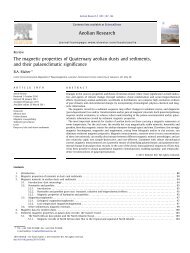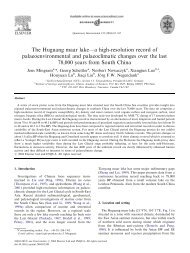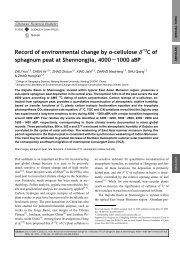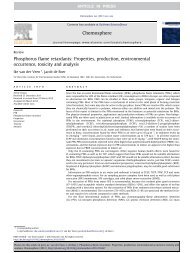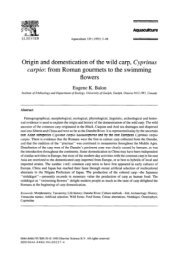Mono- and dicyclic unsaturated triterpenoid hydrocarbons in ...
Mono- and dicyclic unsaturated triterpenoid hydrocarbons in ...
Mono- and dicyclic unsaturated triterpenoid hydrocarbons in ...
Create successful ePaper yourself
Turn your PDF publications into a flip-book with our unique Google optimized e-Paper software.
890 R. de Mesmay et al. / Organic Geochemistry 39 (2008) 879–893<br />
(f1, f2 <strong>and</strong> h), ii) masokocenes (i.e. <strong>dicyclic</strong> botryococcenes:<br />
c, d, e <strong>and</strong> j) <strong>and</strong> iii) partially reduced botryococcenes<br />
(a, b, g1, g2 <strong>and</strong> i, Fig. 9). It is noteworthy that all the<br />
monocyclic botryococcenes <strong>and</strong> their derivatives have a<br />
cyclohexenyl moiety <strong>in</strong> the left h<strong>and</strong> side of the molecule.<br />
No monocyclic compound with one r<strong>in</strong>g on the right side<br />
of the molecule has been characterized <strong>in</strong> Lake Masoko<br />
sediments, whereas the occurrence of <strong>dicyclic</strong> compounds<br />
<strong>in</strong>dicates that both sides of the molecule can be cyclized.<br />
Except for a, all the structures <strong>in</strong> Lake Masoko are cyclic,<br />
whereas botryococcenes found <strong>in</strong> sediments or pure stra<strong>in</strong><br />
cultures are mostly acyclic (Metzger <strong>and</strong> Largeau, 1999). B.<br />
braunii microalgae <strong>in</strong> Lake Masoko 32,000 years ago produced<br />
nearly exclusively cyclic botryococcenes, which is<br />
quite <strong>in</strong>trigu<strong>in</strong>g. The virtual lack <strong>in</strong> this sample of acyclic<br />
botryococcenes, likely to be the precursors of cyclic botryococcenes,<br />
suggests an efficient mechanism of cyclisation.<br />
The absence of compound k <strong>and</strong> of the monocyclic C 35 botryococcene,<br />
probable precursors for masokocenes c <strong>and</strong> e,<br />
respectively, means that the second cyclisation is also efficient.<br />
The occurrence of f1 <strong>and</strong> f2 suggests that their cyclisation<br />
to j is probably less efficient due to the steric effect<br />
of the methyl <strong>and</strong> ethyl groups on the C-21/C-22 double<br />
bond. The stronger steric effect <strong>in</strong> h may prevent further<br />
cyclisation to C37 masokocene.<br />
In all partially reduced botryococcenes <strong>in</strong> the sample (i.e.<br />
a, b, g1, g2 <strong>and</strong> i), the most easily reducible double bond (C-<br />
26/C-27) is left unchanged compared with the correspond<strong>in</strong>g<br />
botryococcene. Moreover, only one peak for each compound<br />
a <strong>and</strong> b was detected from GC analysis (Fig. 2A), suggest<strong>in</strong>g<br />
the formation of only one diastereoisomer for a <strong>and</strong> b via biotic<br />
reduction of parent botryococcenes. However, <strong>in</strong> the light<br />
of the recent work of Hebt<strong>in</strong>g et al. (2006) on the preservation<br />
pathway of sedimentary organic carbon, an abiotic process<br />
cannot be entirely excluded. For the other partially reduced<br />
botryococcenes g1 <strong>and</strong> g2, we attribute the occurrence of<br />
two stereoisomers to the Z <strong>and</strong> E stereochemistry of the C-<br />
21/C-22 double bond rather than to hypothetical diastereisomers<br />
that would be formed by an abiotic process (Hebt<strong>in</strong>g<br />
et al., 2006). We then assess that all partially reduced compounds<br />
<strong>in</strong> the ca. 32,000 year old sediments from Lake Masoko<br />
arise from a biotic process. Huang <strong>and</strong> Murray (1995)<br />
<strong>and</strong> Huang et al. (1996) reported similar observations on<br />
some reduced botryococcenes found <strong>in</strong> sediment from<br />
Sacred Lake (Kenya), <strong>and</strong> suggested that they could orig<strong>in</strong>ate<br />
either from a variant population of B. braunii race B or from a<br />
microbial reduction. Moreover, the possibility of a microbial<br />
reduction dur<strong>in</strong>g early diagenesis was recently proposed to<br />
expla<strong>in</strong> the occurrence of partially reduced cyclic <strong>and</strong> acyclic<br />
botryococcenes <strong>in</strong> soils of the Everglades wetl<strong>and</strong>s (Gao et al.,<br />
2007). In the present case, it is noteworthy that the only acyclic<br />
structure <strong>in</strong> this sample is the partially reduced C34 botryococcene<br />
a. This could suggest an <strong>in</strong> vivo competition<br />
between reduction <strong>and</strong> cyclisation dur<strong>in</strong>g biosynthesis. Cyclisation<br />
cannot occur after reduction of double bonds C-1/C-2,<br />
C-6/C-24, C-17/C-29 or C-21/C-30. Partial reduction of l to a<br />
prevents cyclisation occurr<strong>in</strong>g <strong>in</strong> the left h<strong>and</strong> moiety. Furthermore,<br />
<strong>in</strong>creas<strong>in</strong>g steric h<strong>in</strong>drance due to the successive<br />
effects of the methylation of the same isoprenoid unit results<br />
<strong>in</strong> a strong decrease <strong>in</strong> the proportion of <strong>dicyclic</strong> masokocenes<br />
(from 100% of C 35,downto14%ofC 36 <strong>and</strong> no C 37).<br />
4. Conclusions<br />
Biomarkers specific for the alga B. braunii race B are the<br />
ma<strong>in</strong> constituents of the hydrocarbon fraction extracted<br />
from a ca. 32,000 year old sediment <strong>in</strong>terval from Lake Masoko,<br />
Tanzania. Thanks to GC-MS <strong>and</strong> NMR <strong>and</strong> chemical<br />
degradation, ten new cyclic botryococcenes <strong>and</strong> partially<br />
reduced derivatives were identified. Three C34 to C36 dicyclobotryococcenes,<br />
named masokocenes, were characterized,<br />
along with seven C34 to C37 monocyclic compounds.<br />
The structures <strong>in</strong>dicate that the monocyclic botryococcenes<br />
(CnH2n-10) are likely <strong>in</strong>termediates <strong>in</strong> the biosynthesis of the<br />
<strong>dicyclic</strong> analogues, while the partially reduced botryococcenes<br />
(C nH 2n-2, C nH 2n-6 <strong>and</strong> C nH 2n-8) are likely end products.<br />
The study widely extends the number of molecular structures<br />
with<strong>in</strong> the botryococcene family.<br />
From a biogeographical po<strong>in</strong>t of view, the study also re<strong>in</strong>forces<br />
the idea that botryococcene-produc<strong>in</strong>g B. braunii<br />
would be a rather common colonizer of crater (Huang<br />
et al., 1999; Zhang et al., 2007) <strong>and</strong> maar (Fuhrmann et al.,<br />
2003) lakes, just like reservoirs (Wake <strong>and</strong> Hillen, 1981),<br />
dams (Metzger et al., 1985a; David et al., 1988; Metzger<br />
et al., 1988; Jaffé et al., 1995) <strong>and</strong> also water tanks (Wolf<br />
et al., 1985; Okada et al., 1995), under almost all latitudes<br />
<strong>and</strong> from the sea level up to alp<strong>in</strong>e zones. Known as a freshwater<br />
alga, race B of B. braunii has been also reported to be<br />
present <strong>in</strong> some mar<strong>in</strong>e environments (e.g. Grice et al.,<br />
1998; Smittenberg et al., 2005). Physical <strong>and</strong> chemical conditions<br />
favour<strong>in</strong>g its growth <strong>in</strong> some lakes, lead<strong>in</strong>g sometimes<br />
to endur<strong>in</strong>g blooms (e.g. Wake <strong>and</strong> Hillen, 1981; Metzger<br />
et al., 1985a; Townsend, 2001), are still poorly understood.<br />
Although the preference of B. braunii race B for acidic waters<br />
is often noted, the pH does not seem to be a critical parameter<br />
s<strong>in</strong>ce this microalga has been found <strong>in</strong> environments with<br />
pH up to 8.6. Besides, it would appear from the literature (e.g.<br />
Swale, 1968; Wake <strong>and</strong> Hillen, 1980, 1981; Metzger et al.,<br />
1985a; Huang et al., 1999; Reynolds, 2000; Townsend,<br />
2001; Zhang et al., 2007), that it generally grows <strong>in</strong> rather<br />
small oligotrophic lakes (ca 1–2 km 2 or less) with a small<br />
catchment area. However, the alga can be also present <strong>in</strong><br />
some great lakes like Michigan (Wolf <strong>and</strong> Cox, 1981). Studies<br />
are currently <strong>in</strong> progress to determ<strong>in</strong>e the physicochemical<br />
<strong>and</strong> environmental factors that could be at the orig<strong>in</strong> of the<br />
variation of the distribution <strong>and</strong> abundance of botryococcenes<br />
observed <strong>in</strong> the sediments of Lake Masoko.<br />
Acknowledgments<br />
M. Delal<strong>and</strong>e, D. Williamson <strong>and</strong> L. Bergonz<strong>in</strong>i are<br />
thanked for helpful comments <strong>and</strong> discussions. We also<br />
thank Yongsong Huang <strong>and</strong> Hans-Peter Nytoft reviews <strong>and</strong><br />
constructive comments. The work was supported by the<br />
Centre National de la Recherche Scientifique (CNRS) through<br />
the CLEHA research programme from ECLIPSE-INSU <strong>and</strong> by<br />
the Institute of Resource Assessment (IRA) at University of<br />
Dar es Salaam. We are grateful to C. Fosse (ENSCP, Paris)<br />
for exact mass determ<strong>in</strong>ation <strong>and</strong> to M.-N. Rager (ENSCP,<br />
Paris) for NMR spectral measurements. This paper is contribution<br />
2 of the Rungwe Environmental Science Observatory<br />
Network (RESON) <strong>and</strong> contribution 07.50 of UMR 5125 PEPS.



